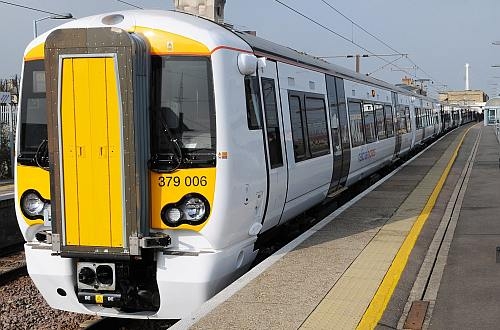The project is being undertaken by a partnership of Network Rail (NR), Bombardier, the operator Greater Anglia, the Department for Transport (DfT), and the Enabling Innovation Team (EIT) which was set up to accelerate the adoption of railway innovations. The initiative is being funded by NR, DfT and EIT.
A Greater Anglia class 379 emu built by Bombardier will be fitted with two types of battery: lithium (iron-manganese) phosphate and hot sodium nickel salt. However, the batteries will be tested in a laboratory before being installed on the train.
The train will then be tested on the Old Dalby test track and elsewhere away from the live railway. If the trials are successful, the train will operate with its pantograph down on a Greater Anglia electrified branch line, both with passengers on board and empty. This will allow the train to switch to conventional electric operation in the event of a problem with the batteries. The test programme should be completed by the end of next year, when the batteries will be removed so that the train can return to normal operation.
"If we can create an energy storage capability for trains, electric traction can be introduced to more parts of the network without the need to necessarily extend the electrification infrastructure," says Mr Richard Eccles, NR's director of network strategy and planning. "As the principle funder and delivery manager, we have done a great deal of feasibility work before reaching this stage, both to define the outputs we seek from the trial and to build confidence in the project across the industry."
WORK has started to create a prototype battery-powered emu which can operate beyond the catenary as way of extending the benefits of electric operation as Britain electrifies more of it national rail network.
The project is being undertaken by a partnership of Network Rail (NR), Bombardier, the operator Greater Anglia, the Department for Transport (DfT), and the Enabling Innovation Team (EIT) which was set up to accelerate the adoption of railway innovations. The initiative is being funded by NR, DfT and EIT.
A Greater Anglia class 379 emu built by Bombardier will be fitted with two types of battery: lithium (iron-manganese) phosphate and hot sodium nickel salt. However, the batteries will be tested in a laboratory before being installed on the train.
The train will then be tested on the Old Dalby test track and elsewhere away from the live railway. If the trials are successful, the train will operate with its pantograph down on a Greater Anglia electrified branch line, both with passengers on board and empty. This will allow the train to switch to conventional electric operation in the event of a problem with the batteries. The test programme should be completed by the end of next year, when the batteries will be removed so that the train can return to normal operation.
“If we can create an energy storage capability for trains, electric traction can be introduced to more parts of the network without the need to necessarily extend the electrification infrastructure,” says Mr Richard Eccles, NR’s director of network strategy and planning. “As the principle funder and delivery manager, we have done a great deal of feasibility work before reaching this stage, both to define the outputs we seek from the trial and to build confidence in the project across the industry.”

